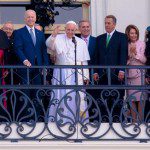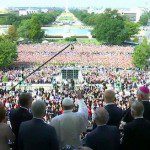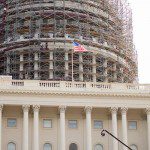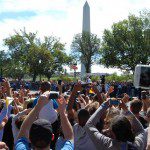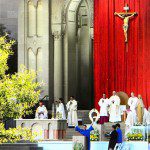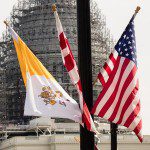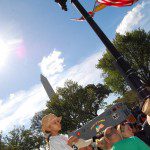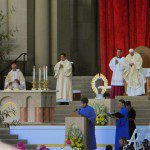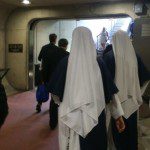Pope Francis Completes Transformational Visit to Washington, D.C.
By • October 5, 2015 0 1823
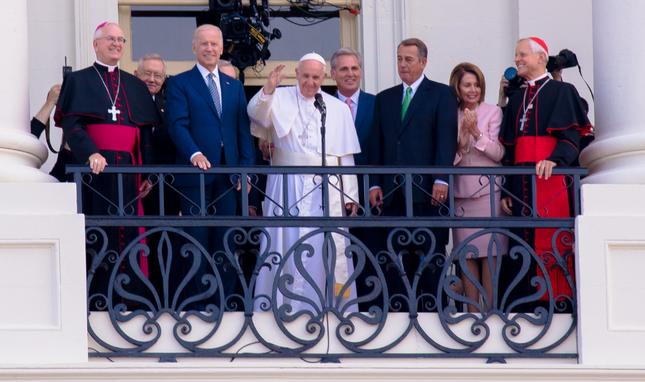
Scroll down to view more photos of the pope’s visit to Washington, D.C., beneath the story.
History these days is simultaneous, swift and capricious in its making.
But beginning with Tuesday evening, filling up all of Wednesday and running through more than half of Thursday, history was made, to be sure, but time also seemed to stop. This was the time of Pope Francis in Washington, and his presence managed to blot out most of the rest of the news, while bringing out a serendipitous sun and perfect weather for the duration of his stay.
From the moment his plane landed at Joint Base Andrews after a flight from Cuba for the first leg of his first trip (ever) to the United States, where he was greeted by President Barack Obama and his family, military and government officials and the first of a host of children, the pope made history, set precedents and captivated this city—which is, still and all, the center of the world. In that time, Francis became the center of the center of the world.
He set out on a mission and what became a grueling schedule, especially for a 78-year-old man: Wednesday began at 9:15 a.m. with an Official State Welcome and Meeting with the president, followed by a short, but massively attended parade between the ellipse and a portion of the National Mall, followed by an 11:30 a.m. Midday Prayer at the Cathedral of St. Matthew the Apostle with a gathering of U.S. Catholic Bishops and church leaders. At 4:15 p.m., after a brief rest at the Nunciato, the Papal Embassy in Washington, D.C., on Massachusetts Avenue, the pope traveled in his now famous Fiat to the Basilica of the National Shrine of the Immaculate Conception for a Mass of Canonization of Blessed Junipero Serra, the Spanish friar who was principally responsible for the construction of a series of monasteries in California, and the conversion of the indigenous population there.
After the outdoor Mass on part of the grounds of the Catholic University of America, there was a stop at a seminary and a return to the Nunciato. The following morning, Francis traveled to Capitol Hill for a first-ever address by a pope to a joint session of Congress, followed by an address to the crowd of thousands who had gathered outside at the West Front of the U.S. Capitol. This was followed by a visit to St. Patrick’s Church in the City, where the Catholic Charities organization ministers to a congregation that includes large numbers of homeless people.
The obviously hectic schedule does not begin to measure the effect of the pope’s presence, the outpouring of adoration, love and affection, an outpouring from the people for the pope, but also the pope for the people he encountered with obvious relish.
Francis came, spoke at every turn and conquered. He inspired mightily. He hugged and embraced. He spoke in English with increased confidence. He was the Francis whom everyone had heard and heard about. He brought with him his reputation for humility, his keen intelligence, an undeniable warmth and hope from a bottomless basket.
For the duration of his stay, this city became both Catholic and catholic—which seems to define the pope’s style. During the outdoor Mass, in the prayer service, all the church’s great capacity for pomp shone in ways that were not ostentatious but appropriate to the circumstance, which had the rhythms of both an expansive historic and formal event, and a series of intimate encounters within the framework of the presence of thousands.
For the press, media, for law enforcement and for the city’s much maligned and beleaguered transportation system, the presence of the pope presented enormous challenges—the tension inherent in the protection of such a giant figure in the world’s consciousness with attendant security issues, for instance, and the use of resources by television and print organizations in deploying reporters and reporting without bias or over-adoration. For Metro, the task was especially difficult—just the day before a train broke down in a tunnel. Yet at first glance, the city’s institutions performed admirably.
Catholic observers—those practicing their faith rigorously, those not so regular or those fallen away or lapsed—were awash in nostalgia: one veteran television reporter mentioned channeling his inner altar boy. This writer recalled being confirmed in a cathedral dedicated to the Virgin Mary outside a walled medieval city in post-war Germany in Bavaria, the Catholic center in a predominantly Protestant country.
With Francis presiding over the Mass of Canonization for now St. Juniper Serra—also a first on North American soil and issue of some controversy and consequence in the Hispanic and Native American community—or at St. Matthews where red-hat cardinals and bishops came up for words with the pope, the pomp and propensity for stylized ritual is noticeable and moving—or impressive. A Mass like this one, near twilight outdoors, with thousands in attendance—including Vice President Joe Biden, can be a solemn, beautiful experience. The pope praised Serra, whose statue now accompanies that of President Ronald Reagan’s in the Statuary Hall in the Capitol. Francis’s theme—or one of many—on this journey has been about engagement, encounters, about spreading the joy, about involvement with others.
The pope’s speech to the Joint Session of Congress was something of a marvel: equal parts inspiration, a diplomatic, but nonetheless emphatic speech, one that dealt with all the primary issues of the day that divide this country and the world—abortion, gay marriage, family, climate and the environment, the duty of politics. His English becoming clearer with every word, Francis had attendees right at the start, when he said, “I am most grateful for your invitation to address this Joint Session of Congress in the land of the free and the home of the brave.” As the saying goes, the crowd roared, with every member so capable jumping out of their seats.
For a spiritual leader, Pope Francis had a lot to say about politics, and every word he managed to say made the words and speeches of the men and women running for office (some of whom were in the audience) seem small and small-minded. He proposed to define politics for the men and women in congress who have spent too much of their time in the service of getting elected, a process that here and in many other places seems to be suffering a serious bout of uncertainty. “You are the face of the people, their representatives. You are called to defend and preserve the dignity of your fellow citizens in the tireless and demanding pursuit of the common good, for this is the chief aim of politics.” (Donald Trump was not present.)
Francis called on the legislators to care for the hopeless, the poor and the people who have lost their way. Such concern comes directly from Jesuit doctrine, for Francis is, above all, not just the pope but a Jesuit, the church’s chief defenders and also its questioners and warriors for the poor. He urged dialogue, engagement, encounter, time and time again. He called for dialoguing with the elderly and become involved with them. He described the world as a place of violent conflict, hatred and brutal atrocities, committed even in the name of God and of religion. “Our response ,” he said, “must be one of hope and healing of peace an justice.”
The pope built his speech around the lives of four uniquely original Americans: President Abraham Lincoln, Martin Luther King, Jr., Dorothy Day and Thomas Merton—two of whom were assassinated.
Francis stated his full support for life—and condemned the death penalty. He stated his full support for the family, both of which seemed to be his way of touching upon, but without mentioning, abortion or gay marriage. He urged a world conversation about the environment, the “health of the planet,” about ways to “avert the most serious effects of the environmental deterioration caused by human activity.” Now is the time, the pope said, for “courageous actions and strategies aimed at implementing a “culture of care.” Notably, many House Republican members failed to applause, while Democrats did.
Basically, he seemed to say that America must embrace its virtues, political and social, “the richness of your cultural heritage, of the spirit of the American people. It is my desire that this spirit continue to develop and grow so that as many young people as possible can inherit and dwell in a land which has inspired so many people to dream.”
Francis did not scold and did not chastise. Like the shepherd of the church that he is, the pope sought to reconcile, engage and gather together.
He did this by example. He suffered a few children to come unto him after his White House greeting during the short parade, called “Encounter Francis on the National Mall,” Sept. 23.
More importantly, perhaps the best place to actually encounter the pope was in front of the Vatican embassy. Every day and night, many people, many children, gathered to see, hear and engage the pope. And upon his every departure and return, he engaged the people.
He wrapped his arms around the children, spoke, or posed for selfies with love and delight. What you remember the most was his arrival after the Mass, night having fallen. He exited the small Fiat and appeared exhausted, wobbly, walking very slowly. The noise of the crowd in front of the Vatican Embassy was as loud as ever—a clarion call, if you will.
He turned around slowly and waded into the crowd of outstretched hands and voices, smiling, arms outstretched.
- Pope Francis at the West Front of the U.S. Capitol Sept. 24. | Jeff Malet
- Courtesy Kreeger Museum.
- Courtesy Park Avenue Armory.
- Photo by Sam Kittner. Courtesy Georgetown BID.

